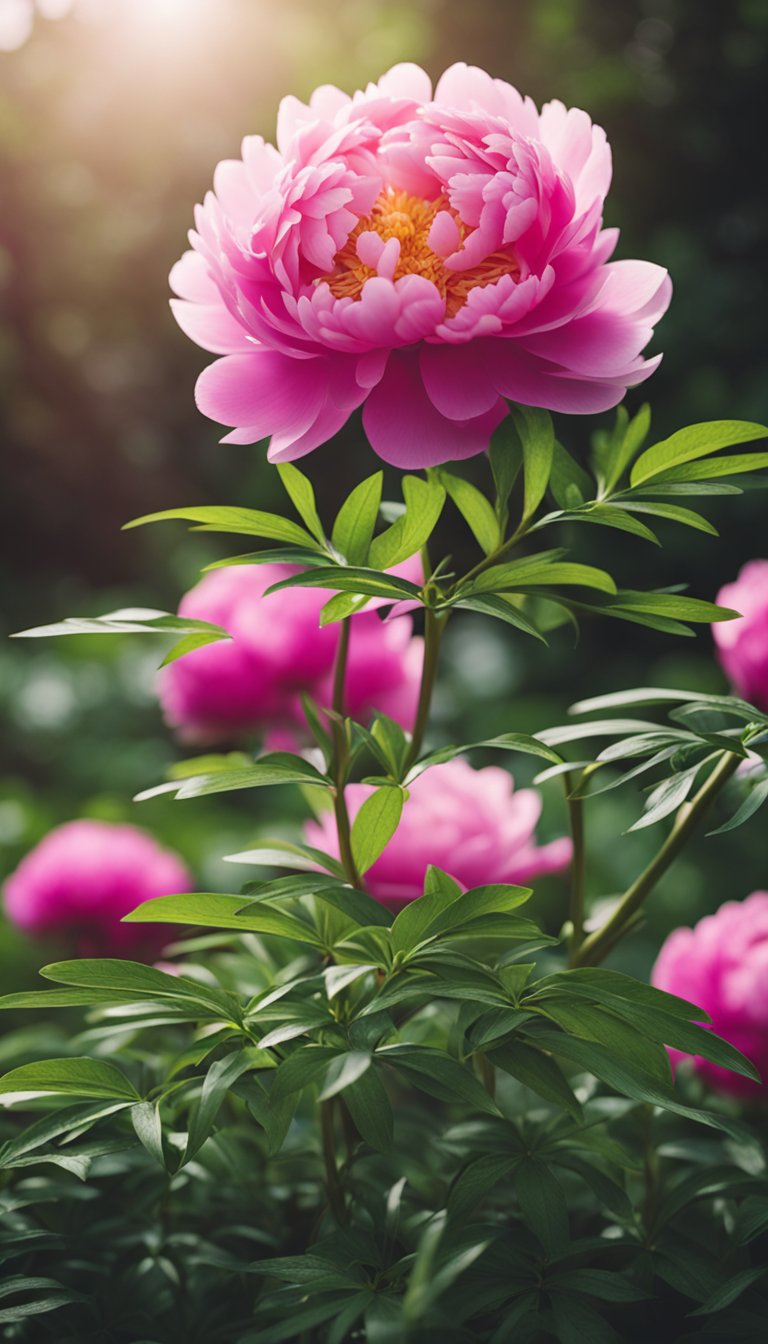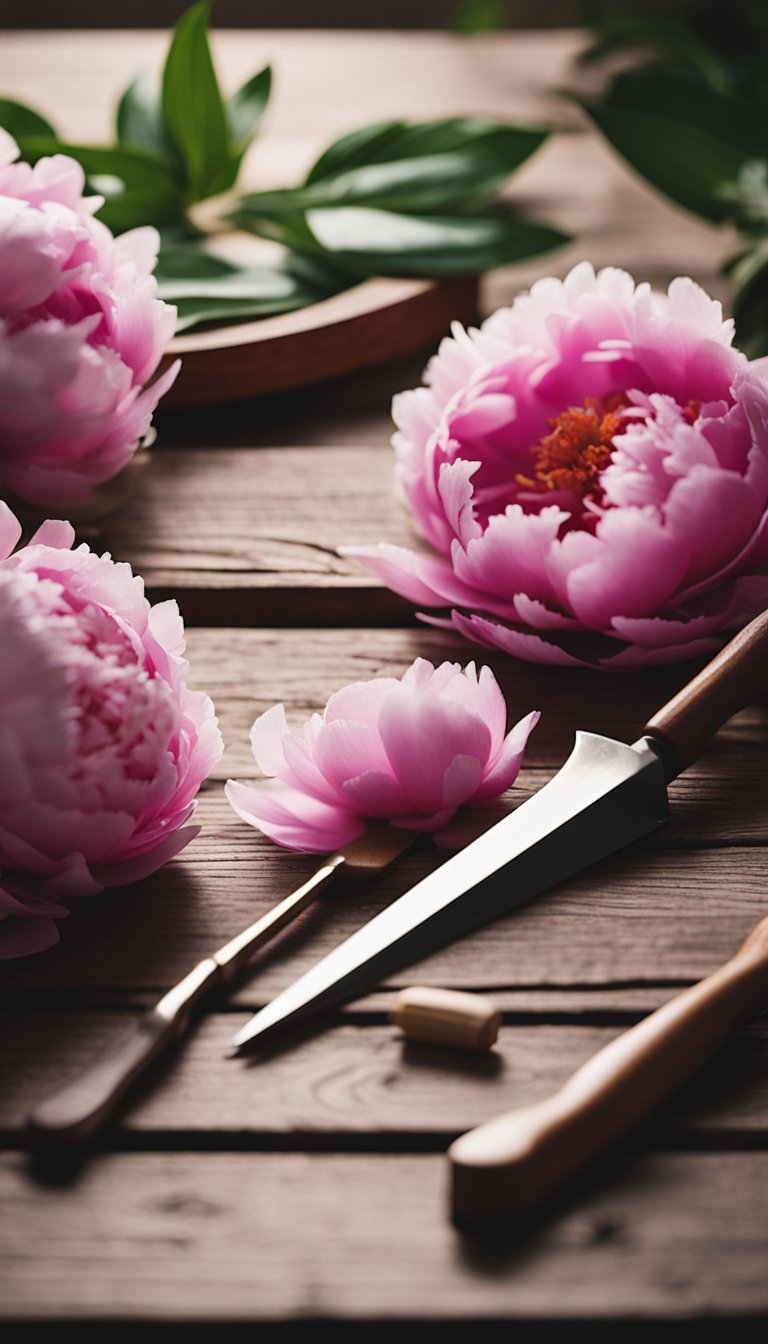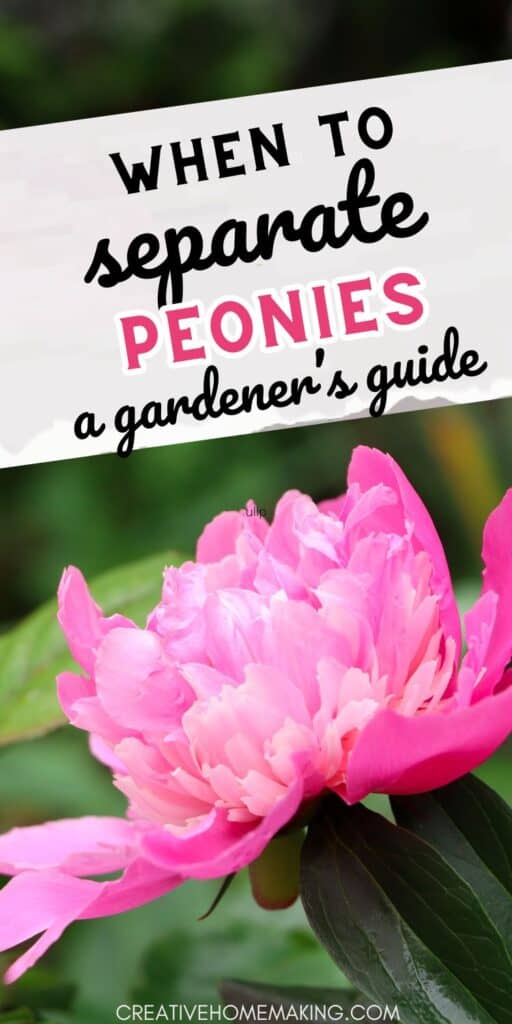Are you a gardening enthusiast looking to enhance the beauty of your outdoor space with peonies? If so, you may be wondering when the best time is to separate these gorgeous plants.
This post may contain affiliate links.
Separating peonies is a crucial step in their growth process, and it can help promote healthier plants and more abundant blooms. In this article, we’ll explore when and how to separate peonies to ensure that they thrive in your garden.
Peonies are a popular choice for gardeners due to their stunning, fragrant blooms and easy-to-care-for nature. However, as they grow, they can become overcrowded, leading to stunted growth and fewer flowers.
Separating peonies is essential to ensure that they have enough space to grow and thrive. In this article, we’ll cover everything you need to know about when to separate peonies, including the signs to look for and the best time of year to do it.
So, whether you’re a seasoned gardener or new to the world of planting, read on to learn more about this crucial step in peony care.
Related Article: Transplanting Peonies in Spring: A Quick Guide
Understanding Peonies and Their Growth Cycle
The Biology of Peonies
Peonies are perennial plants that grow from fleshy roots. They are known for their large, showy flowers and come in a variety of colors, including white, pink, red, and yellow. Peonies have sturdy stems that support their heavy blooms and lush foliage.
The leaves of peonies are deeply lobed and can range in color from dark green to blue-green. They are an important part of the plant’s growth cycle, as they produce energy through photosynthesis, which is necessary for the development of the flower buds.
Peonies bloom in the late spring to early summer, depending on the variety and location. The flowers are large and fragrant, with many petals arranged in a cup shape. After the flowers have bloomed, they produce seed pods that can be harvested and planted to grow new peony plants.
Seasonal Changes and Peony Care
Peonies require specific care throughout the year to ensure healthy growth and abundant blooms. In the fall, after the foliage has died back, it is important to cut the stems down to ground level and remove any dead or diseased leaves.
This helps prevent the spread of disease and ensures that the plant will have enough energy to produce new growth in the spring.
In the spring, it is important to fertilize the soil around the plant to provide the necessary nutrients for growth. Peonies also require regular watering, especially during dry spells, to ensure that the soil stays moist.

As the weather warms up and the flower buds begin to form, it is important to support the stems with stakes or cages to prevent them from bending or breaking under the weight of the blooms. This will also help ensure that the flowers are displayed to their best advantage.
Optimal Conditions for Peony Health
Peonies are beautiful and vibrant flowers that require specific conditions to thrive. In order to ensure the health and longevity of your peonies, it is important to understand the optimal growing conditions for these plants.
Soil and Sunlight Requirements
Peonies require well-draining soil and full sunlight to thrive. The soil should be rich in organic matter and have a pH level between 6.0 and 7.0. If you have heavy clay soil, adding compost or other organic matter can help improve drainage and provide nutrients for the plant.
When planting your peonies, make sure they are placed in an area that receives at least six hours of direct sunlight per day. If your peonies are not receiving enough sunlight, they may produce fewer blooms and become more susceptible to disease.

Watering and Fertilizing Practices
Peonies require regular watering, especially during the growing season. However, it is important not to overwater them, as this can lead to root rot and other issues. Water your peonies deeply once a week, or more frequently during hot, dry weather.
Fertilizing your peonies can help promote healthy growth and vibrant blooms. Use a balanced fertilizer in early spring, before the plant begins to grow. You can also apply a layer of mulch around the base of the plant to help retain moisture and add nutrients to the soil.
The Right Time to Divide and Transplant Peonies
Peonies are beautiful and long-lasting flowers that can thrive for decades in the same spot if taken care of properly.
However, there comes a time when your peonies need to be divided and transplanted to ensure their continued health and beauty. In this section, we will discuss the signs for division and the best timing for minimal stress.
Identifying Signs for Division
The first sign that your peonies need to be divided is when they start to produce fewer flowers than usual. This is a clear indication that the plant has outgrown its current location and needs more space to grow. Another sign is when the center of the plant starts to die off, leaving only a ring of healthy growth around the outside.
To check if your peonies are ready for division, look for the number of “eyes” on the plant. These are small, reddish buds that will eventually grow into new stems. If your peony has fewer than three to five eyes, it’s time to divide and transplant.
Best Timing for Minimal Stress
The best time to divide peonies is in late summer or early fall when the plant is dormant. This is typically after the first frost of the season. Dividing peonies during this time will minimize the stress on the plant and give it plenty of time to establish itself before the next growing season.
When dividing your peonies, make sure to dig up the entire plant, including the root ball. Gently shake off any excess soil and use a sharp, clean knife to cut the plant into sections. Each section should have at least three to five eyes and a healthy root system.
Step-by-Step Guide to Dividing Peonies
Peonies are beautiful and long-lasting flowers that can add color and vibrancy to any garden. However, as they grow, they can become crowded and need to be divided. Here is a step-by-step guide to help you divide your peonies and keep them healthy:
Preparing to Lift the Plant
Before you begin, make sure you have a sharp knife, a spade, and a hose nearby. Start by watering the plant the day before you plan to divide it. This will help loosen the soil and make it easier to lift the plant.
On the day of the division, dig around the clump of peonies with the spade, being careful not to damage the roots. Lift the plant out of the hole and shake off any excess soil.
Cutting and Separating the Root Ball
Using your sharp knife, cut the root ball into sections. Each section should have at least three to five buds and a healthy root system.
Be patient and take your time to ensure that each section is cut cleanly. Once you have cut the sections, gently separate them from each other, being careful not to damage the roots.
Replanting Divided Sections
Choose a new location for each divided section. Dig a hole that is twice as wide as the root ball and deep enough to accommodate the roots.
Add some compost to the bottom of the hole, and then place the divided section in the hole. Make sure the top of the root ball is level with the soil. Backfill the hole with soil, and then water the plant thoroughly.
Dividing peonies can be a bit challenging, but with a little patience and care, you can ensure that your plants will thrive.
Remember to water your newly transplanted peonies regularly and keep an eye on them to ensure they are healthy. With proper root division and replanting, your peonies will continue to bloom beautifully year after year.
Aftercare for Newly Transplanted Peonies
Congratulations on successfully transplanting your peonies! Now that they are settled in their new location, it is important to provide them with proper aftercare to ensure their successful regrowth and protection from winter conditions.
Ensuring Successful Regrowth
To promote healthy regrowth, it is important to keep the foliage and blooms of your peonies well-maintained. Remove any dead or damaged foliage and blooms to prevent the spread of disease and encourage new growth.
Mulching around the base of your peonies with peat moss can also help retain moisture and provide nutrients to the soil. Be sure to keep the mulch at least a few inches away from the stems to prevent rot.
Water your peonies regularly, especially during dry spells, to keep the soil moist. However, be careful not to overwater as this can lead to root rot.
Protection from Winter Conditions
Peonies are hardy plants, but they still require protection from freezing and thawing during the winter months. Apply a layer of mulch around the base of your peonies to insulate the soil and prevent it from freezing and thawing too quickly.
You can also cover your peonies with burlap or a frost blanket to protect them from harsh winter winds and frost. Be sure to remove the coverings once the danger of frost has passed in the spring.
Frequently Asked Questions
How often should peonies be divided to maintain their health?
Peonies should be divided every 3-5 years to maintain their health and vigor. Overcrowded plants can lead to reduced flowering and disease problems.
What is the best season to transplant peonies for optimal growth?
The best time to transplant peonies is in the fall, after the foliage has died back. This allows the plant to establish roots before the winter and ensures optimal growth in the following spring.
Can peonies be divided and transplanted during the summer months?
While it is possible to divide and transplant peonies during the summer months, it is not recommended. The heat and dry conditions can cause stress and transplant shock to the plant, making it more difficult to establish and grow.
What steps should be taken to minimize transplant shock in peonies?
To minimize transplant shock, it is important to dig up the plant carefully, ensuring that as much of the root system as possible is retained. The plant should be replanted immediately in a hole that is deep enough to accommodate the roots without bending or crowding them.
Water the plant thoroughly after planting and keep the soil moist for the first few weeks.
Should peonies be cut back before they are split and replanted?
Yes, peonies should be cut back to about 6 inches above ground level before they are split and replanted. This helps to reduce the stress on the plant and allows for easier handling during the transplanting process.
What is the process for successfully splitting and replanting a peony?
To successfully split and replant a peony, start by digging up the entire plant, being careful not to damage the roots.
Wash off the soil and use a sharp, clean knife to divide the plant into sections, ensuring that each section has at least 3-5 healthy buds and a good root system. Replant the sections immediately in a well-prepared hole, making sure to water thoroughly after planting.
Follow my gardening board on Pinterest.



